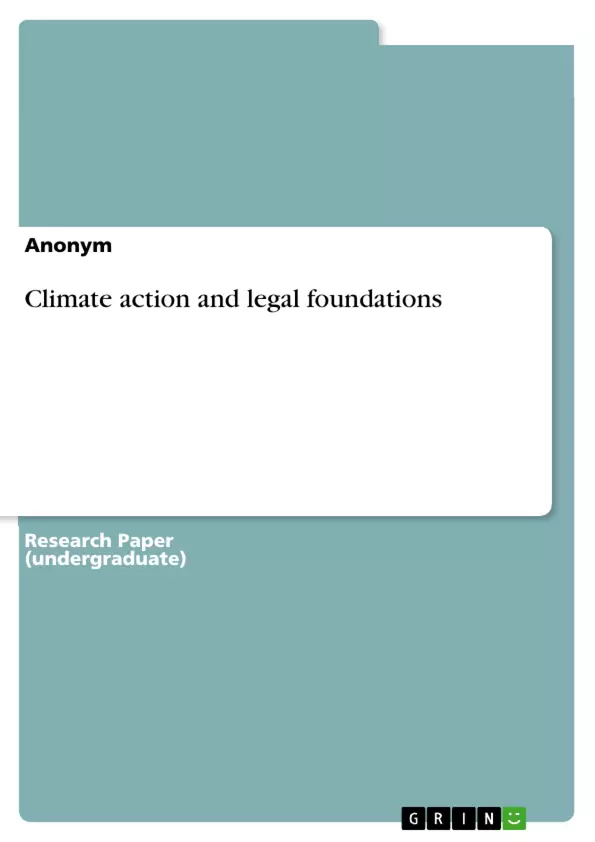This paper analyses the existing laws related climate change and how they support climate action all over the world. Emerging trend of climate change litigation has also caught world’s attention which is being categorized as the ultimate climate action.
The primary methodology tool used is a study of journey taken by the world to accept climate change as a concern and study of laws implemented in furtherance of this concern and conclude whether it is enough or not.
The instant paper contains seven chapters. The first Chapters outlines the gradual shift from climate change to climate action. Second Chapter of the paper discusses the international law related climate change, including climate action initiatives taken under these laws. Climate change litigation is discussed in the third chapter. Fourth and the fifth chapter of the paper outline the Indian perspective and climate change litigation in India respectively. The last chapter elaborates the concept of circular economy.
Climate change and its impact are not limited to a particular region or a particular group of people. Some places may be more vulnerable to its effects than other places, but each and every place on earth is being affected by climate change. A global threat in form of global warming and climate change has been looming over our head for the past century or so. Climate change has been addressed and tackled by various international organizations and treaties. These treaties have formed the basis of International Environmental Law, which is still developing and requires expanding its scope. The main problem with International Environmental Law is its lack of implementation and binding force.
The objective of this research paper is to find out whether the obligatory and binding nature of international law is enough to handle the increasing impacts of climate change or not. Several countries have included environmental law in their existing laws or devised and implemented new laws that under international obligation or good conscience aiming to preserve and protect the environment. Therefore, the research is whether existing legal regime at the national and international level is enough to reverse the damages done to the environment and prevent further damage. Response to climate change has taken a shape of climate action over the years, with people taking active participation in the initiatives taken across the world and binding nature.
Table of Contents
- INTRODUCTION
- CLIMATE CHANGE TO CLIMATE ACTION
- Hot Flares or Ice Age?
- INTERNATIONAL LAW ON CLIMATE CHANGE
- Emergence
- Trail Smelter Case
- United Nations
- UNEP
- Vienna Convention & Montreal Protocol.
- IPCC.........
- UNFCCC
- Kyoto Protocol, 1997.
- Cancun Agreement, 2010......
- Paris Agreement, 2015-
- Convention on Biological Diversity
- Millennium Development Goals..
- 21st Century.....
- CLIMATE CHANGE LITIGATION- A CLIMATE ACTION.
- Urgenda Foundation V. The State of Netherlands, 2015.
- Leghari V. Republic of Pakistan, 2015...
- Armando Ferrao Carvalho & Ors V. The European Parliament and the Council, 2018....
- Massachusetts V. Environmental Protection Agency, 2007.
- Juliana V. United States, 2015.
- Human Rights Approach
- No Harm Rule 'sic utere tuo ut alienum non laedas'
- Precautionary Principle- .....
- Public Trust Doctrine.
- Public Participation Principle- .
- INDIAN POLICY WITH REGARDS TO CLIMATE CHANGE.
- INDIA AND CLIMATE CHANGE LITIGATION …....
- Maneka Gandhi V. Union of India, 1978
- M.C. Mehta V. Union of India, 1991.
- Taj Trapezium Case, 1987
- Kanpur Tanneries Case, 1987
- Vellore Citizens' Case, 1996
- Manushi Sangthani V. Govt. Of Delhi & Ors., 2010...
- CIRCULAR ECONOMY-‘CRADLE TO CRADLE’.
Objectives and Key Themes
This research paper examines the effectiveness of international law in addressing the growing impacts of climate change. It investigates whether the obligatory and binding nature of international law is sufficient to manage climate change and reverse its consequences. The paper explores the evolution of climate action, analyzing the existing laws, initiatives, and emerging trends, including climate change litigation, in response to this global challenge. The paper delves into specific national contexts, particularly the Indian perspective on climate change and climate change litigation in India. It concludes with an exploration of the circular economy as a potential solution.
- The effectiveness of international law in addressing climate change.
- The evolution of climate action and its legal framework.
- The role of climate change litigation in driving environmental protection.
- The Indian perspective on climate change and related legal developments.
- Circular economy as a potential solution for sustainable development.
Chapter Summaries
The first chapter outlines the gradual shift from a focus on climate change to a more active approach of climate action, highlighting the increasing global awareness and concern. Chapter two provides a comprehensive analysis of international law concerning climate change, exploring various international agreements, treaties, and initiatives. The third chapter delves into the emerging trend of climate change litigation, examining significant cases that highlight the growing use of legal mechanisms to address environmental concerns. Chapter four focuses on India's policies and legal framework related to climate change, while chapter five examines specific cases of climate change litigation in India.
Keywords
Climate change, climate action, international law, environmental law, climate change litigation, circular economy, sustainable development, India, international agreements, treaties, initiatives, legal framework, environmental protection, global warming, greenhouse gas emissions.
- Quote paper
- Anonym (Author), 2019, Climate action and legal foundations, Munich, GRIN Verlag, https://www.hausarbeiten.de/document/1477102


